Responsibility for support of technology in teaching and learning at the University of Missouri–St. Louis (UMSL) falls within the Information Technology Services (ITS) unit. Notwithstanding funding challenges, we have been systematically renovating classrooms to meet the demands of increasing campus use of technology in teaching.1 Upgrades have included desks and chairs as well as technological aids such as data projectors, instructor computers, and personal classroom responders ("clickers"). However, even classrooms with laptops are arranged in traditional configurations: instructor station at the front, with student stations in fixed arrangements of straight or curved rows. Figure 1 shows a typical technology-enhanced classroom.
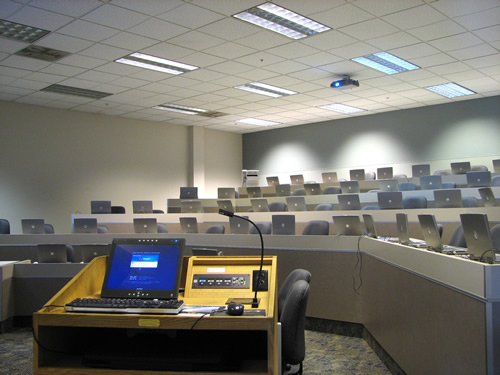
The growing body of recent literature2 on new classroom design encouraged us to begin planning for a different kind of classroom. Given the positive descriptions of spaces at other institutions, embarking on the creation of this new generation of classrooms fell into the category of an investment that UMSL could not afford not to make. If other institutions were improving student outcomes or enrollments because of these new classroom designs, UMSL needed to do so as well, if only to stay competitive.
In this article we describe the planning, creation, use, and initial assessment of our university's first Learning Studio—a space that had to be immediately useful but also unabashedly provocative and experimental. Even with a limited budget, we needed this prototype to guide UMSL in evolving new approaches to learning appropriate to our context. We also needed an efficient process for the project and to demonstrate effectiveness of the resultant space.
Early Indicator
The Learning Studio is an important harbinger of change on the UMSL campus, both in our conceptions of teaching and learning and in our approach to development of physical space. We were struck by how the completed space challenged faculty and students to rethink their possibilities at UMSL and how well it expressed our nascent cultural change. In fact, this article's title3 was suggested by a student entry in the assessment blog created for faculty and students using the new space:
This comment provides a poignant affirmation of the effect of "attractive, well-designed, well-equipped contemporary spaces for teaching and learning" and the creation of "excitement and luster" in student and faculty achievement.5 It also directly addresses our campus goal to increase student recruitment, retention, and engagement.
Context and Process
UMSL is an urban public research university and one of the four campuses of the University of Missouri system. A relatively young campus (roughly 45 years), UMSL has about 10,000 FTE students and some 15,000 headcount—a reflection of the nontraditional nature of the student population. The student body spans a wide spectrum, from older adults returning to finish their baccalaureate or advanced degree to MySpace-cruising "millenials."6 Student success contributes directly to the community, as 75 percent of UMSL graduates work and live in the St. Louis region.
UMSL needs to increase overall enrollment to support our mission as a land-grant university7 but also to improve our fiscal outlook. Achieving this goal depends on both recruitment and retention, which in turn depend on many factors. Many other authors have remarked on the obsolescence of facilities at their institutions as well as the need for enrollment increases.8
The impetus for new classroom design began with a few forward-thinking people, principal among them Bill Klein of the English department. Following an established ITS model, he organized a Provost's Forum on innovative classroom design. The forum attracted more than 60 faculty, staff, and students and launched a working paper that captured the characteristics of an innovative classroom.9
Many authors10 have made the point that physical facilities have long life-cycles, and planning must encompass many different factors, including operational costs. Because of our small budget and desire to move quickly, however, we had to take a more lightweight approach that respected advice from the literature and managed our risks through:
- Focusing on a single classroom
- Being explicit that this first classroom would be an experimental prototype, and yet assuring disciplined planning and design
- Using the recommendations in the working paper and continued involvement of key faculty as resources in planning and design
- Applying established principles and experience from other institutions
- Being explicit about assessment of usage upon completion
As Guy Kawasaki advised,11 "Churn, baby, churn.... Innovation is not an event. It's a process."
One concern that loomed large from the start was finding space in which to establish the new classroom. Serendipitously, the Center for Academic Development was in the process of reorganizing, and the director was intrigued by the potential for repurposing some of the center's space to create a different kind of classroom. ITS and the center agreed to a memorandum of understanding clarifying terms and conditions. With the provost's support, we proceeded with plans to combine two small rooms into a single large room that would accommodate 30–40 students.
Design and Creation
The UMSL working paper articulates several design principles.12 Specifically, learning spaces must:
- Be flexible to accommodate differences in teaching and learning styles, activities, and content.13
- Be social spaces that enable collaboration and interactivity during class time.14
- Address creature comforts and ambiance because these can enable learning in significant ways.15
- Ensure that equipment, facilities, and furniture are accessible to students and teachers and comply with regulations derived from the Americans with Disabilities Act (ADA).16
Guided by these principles and the literature, ITS staff oversaw the overall implementation effort while continuing to involve interested faculty. We also selected a systems integrator, an audio-visual equipment vendor with which we had had good experiences in other projects.17
The system integrator helped with details such as design and control of lighting and selection and placement of display technologies, including two data projectors on opposite ends of the room and a large-format plasma display. ITS provided the firm with a list of preferred features in the AV system and selected equipment based on prioritized needs and costs.
The instructor station has three displays, including a touchscreen. The displays can show the same or different images, as can the large wall displays. The large displays can also be connected to student machines to show their work. Lighting controls are mounted on the wall and at the instructor station.
Our campus interior designer was a key member of the team. She helped with conceptions of the overall environment as well as selection of furnishings, color scheme, and artwork. She also brought the facilities group into the team.
The design and implementation team was truly cross-functional, with a broad range of skills, knowledge, and perspectives. The team also had a clear sense of excitement because we were embarking on a radical yet integrated approach to classroom design at UMSL. An associate dean and other faculty were pleased that we involved faculty in the design of classrooms. As advised in an NLII white paper: "Learning, rather than heating systems, lighting controls, or computer projectors, should be at the center of learning space design."18
Development of the space from conception to operational classroom took about seven months. Figure 2 shows the room's layout and dimensions, and Table 1 lists the components. The carpet is dark shades of brown, orange, blue, and green; the walls are ivory; and the seven pieces of artwork on the walls use coordinating colors. Figure 3 shows elements of the finished studio space: worktables and display screen, couches with crush cans, and presenter's podium.
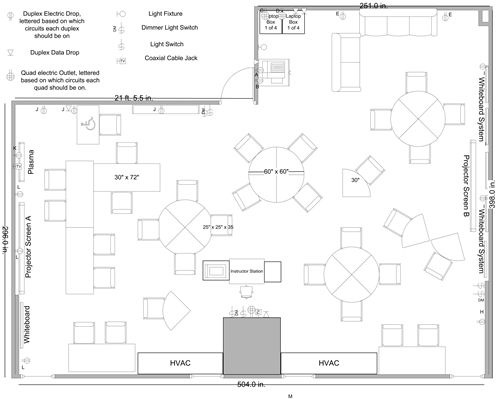
Click image for larger view.
| Table 1 | ||
| Components of the Studio | ||
| Quantity | Component | Colors |
| 5 | Versteel Rectangular Tables | Shoji Screen (marbled tan), Black, Brite White |
| 1 | ADA Versteel Table | Shoji Screen (marbled tan), Black, Brite White |
| 20 | Quarter Round Versteel Tables | Shoji Screen (marbled tan), Black, Brite White |
| 6 | Couch sectional chairs | Nolita (dark yellow) |
| 8 | Steelcase Crush Cans | Lacquer, Black, Nutmeg, Taupe, Raven |
| 31 | Steelcase Cachet Chairs | Black |
| 1 | Design within Reach Bookcase | Red |
| 1 | Spectrum Instructor Podium | Medium wood and black |
| 1 | Mobile Instructor Podium | Mahogany and black |
| 1 | Link Component Cabinet | Grey |
| 4 | Spectrum Laptop Lockers | Grey |
| 1 | 50-inch Plasma TV/monitor | Black |
| 2 | Ceiling Mounted NEC NP1000 data projectors | Grey |
| 1 | Handheld Shure Wireless Microphone | Black |
| 1 | Over the ear Shure Wireless Microphone | Black |
| 2 | Dell GX620 Towers | Grey |
| 31 | Dell Latitude D630 laptops | Grey |
| 3 | Color LCD Crestron Touch Displays | 1 black faceplate, 2 white faceplates |
| 1 | SMART Sympodium touchscreen | Black |
| 2 | Cisco Access Points | N/A |
| 1 | Dibos Security Camera Server | N/A |
| 2 | Bosch Security Cameras | Smoke (dark grey) domes |
| 1 | Topedo Marker Board System | White |
| 2 | Electric Da-Lite Screens | Matte white |
| 10 | Ceiling Speakers | Off-white |
| 1 | Digital Presenter by Samsung | Silver and white |
| 1 | HP 4250 Duplex Printer | Grey |
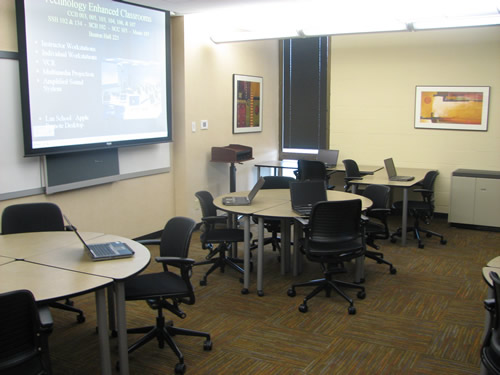
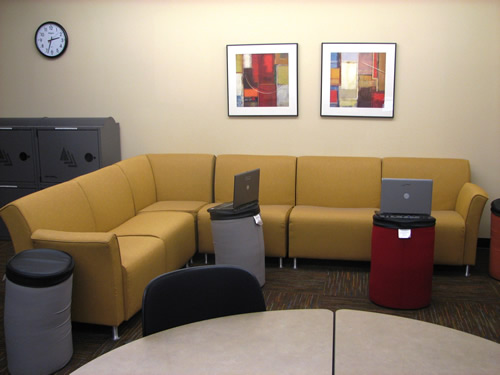
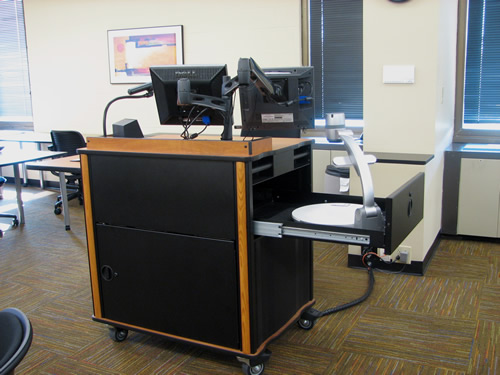
Table 2 provides an approximate cost breakdown. Some costs were reduced because the system integrator waived the usual design fees and contributed the Sympodium touchscreen, while Color-Art Integrated Interiors provided furniture at "demonstration" prices.
| Table 2 | |
| Approximate Budget | |
| Item | Cost |
| Construction | $86,000 |
| AV equipment | $45,000 |
| Furniture | $23,000 |
| Computers | $52,000 |
| Project management | $5,000 |
| Security | $5,000 |
| Interior design | $5,000 |
| Artwork | $1,000 |
| Total | $222,000 |
Assessment
We call the facility a Learning Studio not only because the term "flexible, innovative, technology-enabled classroom" is awkward but also because the term "studio" concisely conveys the sense of:
- Innovation
- A new approach to physical planning
- An experimental space
- A prototype from which the campus will learn how to develop other spaces
- Support for new ways to learn and to teach
These were high expectations of a single classroom renovation. As the component list in Table 1 and images in Figure 3 show, the physical details adhere to the current idiom for this approach to classroom design,19 with features that include:
- Wireless laptops
- Reconfigurable furniture—a selection of easily movable tables and chairs
- Diffuse lighting
- Furnishings, floor, wall treatments and artwork that create a sense of welcome
- Sophisticated lighting and instructor controls
- Several large-screen display options and controls
- A panoply of technologies
We also needed to discover how these accoutrements would enhance teaching and learning, however, and thus contemplated an assessment process from the outset. Although "flexible" classroom projects have been described favorably in print and on the Internet, many of the descriptions contain assertions of effectiveness rather than evidence. We wanted to gather qualitative and quantitative data to show that these kinds of investments could pay off in outcomes important to the institution.
For the spring 2007 semester, 9 instructors taught 16 sections to a total of 203 students using the Learning Studio. The average class size was about 13. With these numbers and at this exploratory stage, qualitative measures and data were the most appropriate way to capture evidence. Although we did include a survey, quantitative measures await further development and longer-term studies.
We realized that the space would be used for many different styles and kinds of teaching and learning, so we used several methods to gather data from as many perspectives as possible:
- Faculty observations
We asked faculty to observe their students' behavior and their own in the Learning Studio. They would try to identify how behavior differed from what they saw in traditional settings and record their observations to share with us.
- Blogs
We asked faculty and students to participate in blogs about the studio classroom. One blog was established for the teachers and one for students in each of the classes. Because we informed participants explicitly that blog entries would be read and analyzed to assess the studio's effects on them, we asked that they record not only their impressions of the space but also reflections on how the space affected their teaching and learning.
- Video observations
A faculty member in one of the English classes asked students to allow themselves to be video recorded as they took part in a collaborative assignment.20 To enable comparison, the same teacher then video recorded students in a different classroom taking part in the same collaborative assignment.
- Surveys
ITS conducts regular surveys of students' use of labs and classrooms. One survey targeted students in classes that used the Learning Studio.
- Faculty debriefing meeting
We planned debriefing meetings at the end of each semester with the faculty users of the Learning Studio.21 The meeting at the end of the first semester (spring 2007) was attended by all nine faculty who had taught in the room. The open discussion was video recorded for later review.22 We evaluated the video systematically to gather comments and synthesize themes.
Outcomes
An early measure of the excitement generated by the Learning Studio was the number of faculty who wanted to use it. We announced availability of the classroom late in fall semester 2006 for classes starting in January 2007, and the facility was about 75 percent booked by the start of the semester. Faculty included instructors from the Center for Languages and Cultures, English, mathematics and computer science, education, and business.
We derived the qualitative results from the survey, the assessment blog,23 and the debriefing meeting video. The 15 students and 8 faculty/staff whoparticipated in the blog generated 37 entries. The debriefing meeting had 19 faculty and staff attendees and lasted almost 2 hours.
The consistent themes that emerged confirm other institutions' experiences. The Learning Studio seemed to encourage a more positive attitude in students and a readiness to become engaged. Students clearly found the environment conducive to learning, judging from their own assessments.
A number of the faculty users came from the Center for Languages and Cultures and taught courses such as Japanese and Spanish in the studio. Instruction in the studio coincided with curricular reform and pedagogical change in the foreign language programs. Faculty in that department unanimously agreed that changes in pedagogy were enabled, facilitated, and informed by use of the studio classroom.
Survey Results
Along with our regular surveys of students' use of technology-enhanced classrooms, we directed a specific survey to students who took classes in the Learning Studio. The results are positive but also preliminary, since we only have one semester of data and 18 respondents from a population of 203. The five survey questions and their responses follow.
Question 1. In your opinion, could this course be taught without student workstations?
- No = 72 percent
- Yes = 22 percent
- N/A = 6 percent
Question 2. Could this course be taught in a traditional classroom without technology?
- No = 78 percent
- Yes = 22 percent
Question 3. In your opinion, did the use of the technology in this room enhance your learning experience for this class?
- No = 0 percent
- Yes = 100 percent
Question 4. How would you rate the overall classroom support?
- Bad = 0 percent
- Poor = 0 percent
- Good = 11 percent
- Very Good = 89 percent
Question 5. How would you rate the overall Technology Enhanced Classroom experience?
- Bad = 0 percent
- Poor = 0 percent
- Good = 0 percent
- Very Good = 100 percent
The Space Is the Message
Student and faculty comments repeatedly evoked the title of this article—the space is the message. Many of the student blog entries directly echoed the sentiments expressed by the first student quote in this article. During the debriefing meeting a faculty member said that the institution conveys an "unspoken message when the institution invests this much time, money, and effort to create this room." Other instructors in the debriefing said they were honored and grateful to be in the room and felt a "sense of responsibility to use the room well." The instructors who had used the Learning Studio expressed a general consensus that students were awed that the university had made this investment. Students had a sense of the studio as a "special place." They appeared more alert and did not slump in their seats as they might in a regular classroom, said the instructors.
These sentiments were also expressed in actions. Faculty cooperated informally to schedule this limited resource, using the studio only when necessary to their lesson plans so that other faculty might have the opportunity to use the space. In this case, scarcity has created cooperation rather than competition. Students call it a "privilege" to have a class in the studio and said they feel "embarrassed" if they don't pay attention while in the room.
These results confirm the statement that:
A student blog entry noted this "refreshing change, to be in a bright cheery space with carpeting and flexible seating"—which also highlights the unfortunate "need to improve the dismal physical condition of many of our regular classrooms," as noted in a faculty blog entry. This contrast raises an issue our campus will need to address, since the unintended consequence may be "haves" and "have-nots" in terms of access to studio learning spaces.
Use of Technology and Support Requirements
The combination of laptops and flexible displays enabled the use of rich media by students and faculty, including video and audio. Because we made it easy to attach laptops to any of the large displays, student-led presentations are quicker and easier to set up. Thus we have a student blog saying, "I personally love to have an individual laptop that can be connected to the big screen." In other classes or meetings, this easy connection to the displays enabled participants, without much prior planning, to take live notes or minutes that were viewable by everyone.
The novelty of the Learning Studio and its array of technologies did require some special handling of training and support. We anticipated some of those needs, inviting instructors to attend orientation and training sessions prior to and during the semester. Classroom support staff also assisted faculty with questions that came up during classes, by phone or with a visit if necessary. Support staff met with instructors before each course to see if laptops would be used and to answer any questions. Staff also met with the instructors at the end of each course.
Classroom support staff spent approximately two hours more a week supporting the Learning Studio compared to the "usual" technology classrooms. Faculty required more support at the beginning of the semester as they learned how to use the features and control system in the room. Towards the end of the semester, faculty continued to have questions regarding features in the room, specifically those they hadn't used at the beginning and wanted to learn about for future semesters.
For one class held by the College of Education, the instructor believed that use of the Learning Studio increased future teachers' awareness of the possibilities of the technology. As she noted in the debriefing, the experience would help the students better integrate technology into the curriculum when they became teachers themselves.
The studio converted at least one student to the use of laptops, as noted in the assessment blog:
Engagement
Students also commented in the assessment blog on the comfortable setting that the Learning Studio provides; one asked, "Why does everything have to be uncomfortable in a school setting?" An instructor noted in the debriefing that because they were comfortable and felt less threatened, students participated more in class. Faculty observed that although other classrooms might have movable furniture (tables and chairs), those spaces don't have the same feel as the studio.
The studio has no obvious "back of the class," so students have no place to hide and no choice but to engage. An instructor remarked during the debriefing on the change in students' demeanors and more active engagement in the class. An even more basic indicator came from the student who blogged, "I have [not] seen students go to sleep like I have in other classrooms." The same comment was echoed by an instructor in the debriefing meeting.
The video recordings of classes show the engagement plainly. Students in the studio interacted with each other more frequently and for longer, and they became more involved in their collaborations, than did their counterparts in the non-studio classroom. Students in the non-studio classroom spent more time typing on their computers and less time interacting with other group members. When they did interact, it was only for brief consultations.
Student and Faculty Learning
In assessment blog postings, students wrote that "more rooms like this...would be a fantastic addition to the learning experience!" and that "this whole classroom seems to be an attempt to just make learning easier."
Faculty in the debriefing observed that the Learning Studio challenged, inspired, and empowered students, causing them to take greater ownership for their learning. By fostering individual initiative, the studio seemed to increase students' level of creativity.
In a Spanish class, as the instructor explained during the debriefing, the facilities (including the technology) empowered students "to communicate in Spanish." The greater interaction between students increased "rehearsal of the language," an obvious way to solidify learning of a foreign language.
The room encourages instructors to "give up the podium," because it facilitates, empowers and encourages teachers to "let loose," said instructors participating in the debriefing meeting. One instructor believes that "the person doing the talking is the one doing the learning," and thus for students to maximize their learning, they must be encouraged to do some of the talking, too. She felt that by giving up the podium, she helped create community and opportunity for the students. As Mitchell wrote, "New types of learning spaces...create new patterns of social and intellectual interaction."25
One instructor found that the facilities and technology in the studio allow curriculum change to happen more easily and made her think about doing things not possible otherwise. She felt that the room
Thus the studio space allows many different ways of interacting with students, including enabling hands-on assistance and modeling learning activities.
A student blog entry observed that the presence of technology forced the instructor to "learn how to use it all," apparently changing their pedagogy in the process. Thus, the studio enabled teacher learning as well as student learning, a positive direction if the institution is to become a learning organization.
Adult Spaces and Collaboration
The flexibility of the studio furniture and the presence of comfortable chairs allowed the creation of social spaces, fostering collaboration and interactivity. The instructor of an evening class told us during the debriefing meeting that the space especially suited the more mature students. The studio's "adult-sized" seating26 also encouraged students to think about themselves as adults. Another instructor commented in the assessment blog, "I am particularly annoyed that a mature graduate student who might work all day in their own office...comes here to sit in a desk/chair designed for high school students." The studio classroom's furniture thus directly addresses the relatively high average age of UMSL students.
The evening class instructor also remarked that a normal classroom would have been no better than sitting at home and taking the class over the Internet. In contrast, the Learning Studio promotes small-group activities and strikes "a good balance between high-tech and high-touch." Despite the sophisticated technology, the room's arrangement appears to encourage more human-to-human interaction. When students have difficulty with particular aspects of technology, their peers are better able to help in the studio space than in another technology-enhanced or traditional classroom.
The studio includes larger rectangular tables in addition to the quarter-round tables. The combination is configurable as a large boardroom table that accommodates over 15 people (see Figure 4), allowing simulation of a workplace environment. The implicit message is that the students are "here to do" in addition to being "here to learn," thus promoting active learning, as noted during the faculty debriefing meeting.
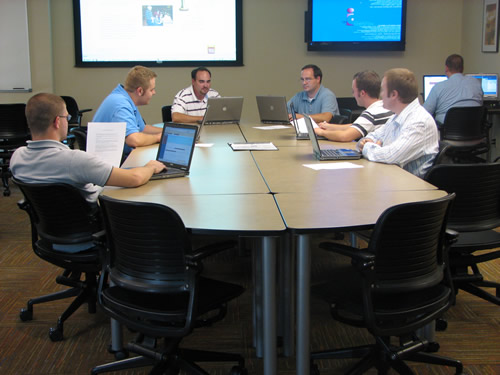
Another instructor found that because the tables move so easily, she could reconfigure the space almost at the last minute. She could be more spontaneous about how she wanted students to interact to achieve the intent of her lesson plan, she explained during the debriefing. This is entirely consistent with the experimental intent of the space. Indeed, one instructor, in both the debriefing and the assessment blog, called the studio an "adult kindergarten"—a playful and active learning environment.
For smaller classes, the variety and size of tables offered more space to spread out students' material. This makes individual and group work more efficient and creates an environment that is more "normal" than a cramped chair/desk combination, as noted in an assessment blog entry.
Accessibility
An early reviewer of this article pointed out a consequence we had not foreseen: the studio appears to be more accessible than other classrooms, better accommodating people with special needs.27 We interviewed an instructor who has difficulty raising her arms to use standard whiteboards; she could use the touchscreen from a seated position to clarify points and annotate classroom notes (see Figure 5, top). The multiple displays can be used to magnify material for students with visual impairments (Figure 5, middle); the worktables can easily accommodate someone in a wheelchair (Figure 5, bottom); and the displays can accommodate captioning for students with hearing impairments. Accessibility is an important avenue for further exploration—the Learning Studio's message is inclusive.
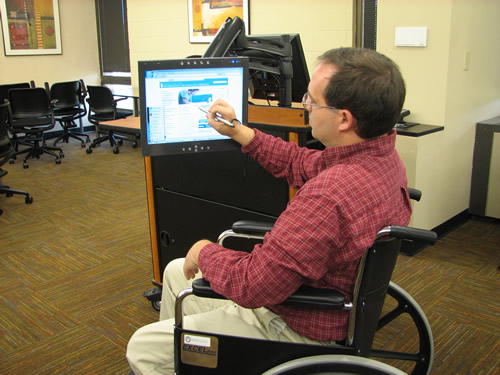
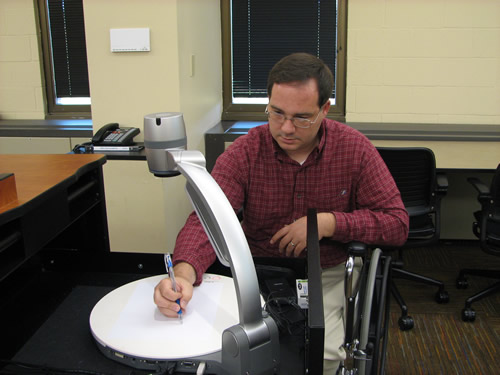
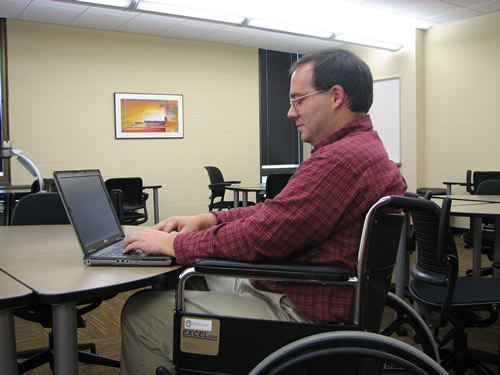
Specific Innovations
Several faculty created specific configurations of the room that we considered innovative and surprising. In a language class, for example, students sit side by side but face opposite directions (see Figure 6). The screens on the facing walls have different material, and the students have to interact in Spanish to "fill in the blanks."
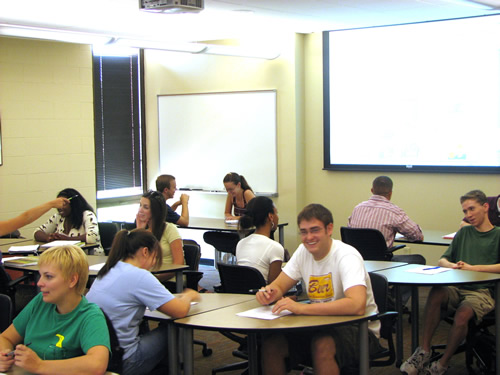
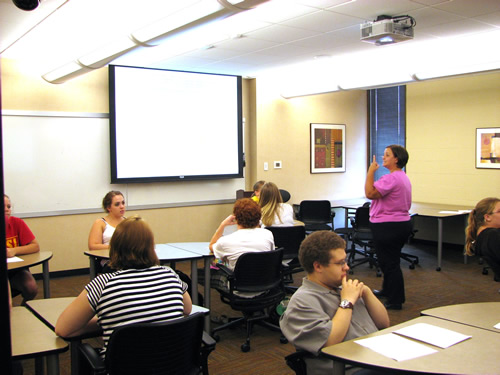
Another instructor used 12 different configurations of the room in the course of the semester. Two arrangements are shown in Figures 7 and 8: a "chain" of tables allowing students to face each other at an offset, and a grouping of comfortable chairs with crush cans for use either as footrests or laptop supports. Both configurations accommodate collaborative or individual work while establishing a specific environment: more formal (the table chain) versus less formal (the grouping of comfortable chairs).
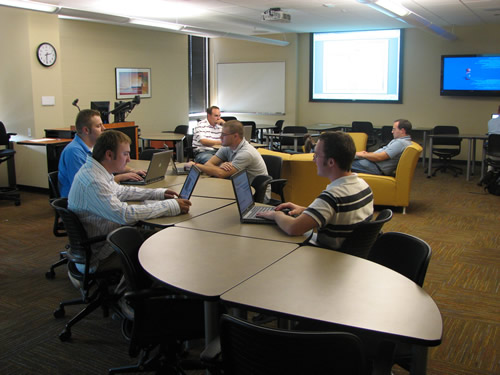
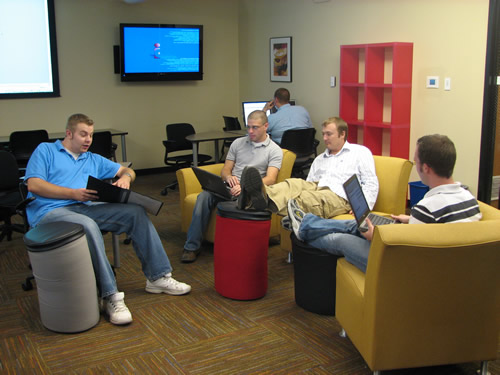
In an English class, students used the quarter-round tables in a new way. These small tables are typically put together as circular tables so that students can sit facing each other. In this class, the students moved the tables apart so that they could sit in the center of the circle facing out (see Figure 9). This might seem to inhibit collaboration, but these students used the laptops for writing and research, and this configuration actually made it easier for them to turn and talk to each other and to show each other what they were doing on their laptop screens.
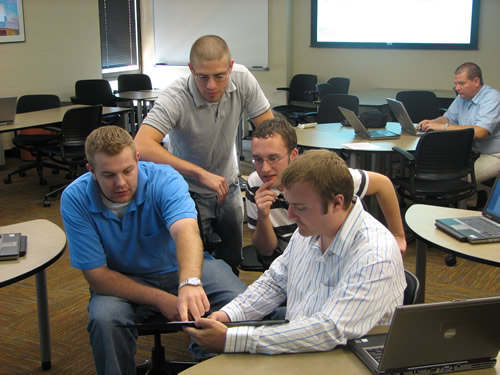
In another language class, the tables were arranged to provide a single desk per student. This configuration gave students sufficient tabletop work space, and enough open space remained between students to make oral assessment using the laptops possible.
Lessons Learned
We learned many lessons throughout the design, creation, and use of the Learning Studio, and our learning continues as other faculty use the space. Some lessons are subtle, while others are obvious in hindsight.
Change Management
The evidence clearly shows that the Learning Studio is an important enabler of change. As more rooms are converted, faculty across the institution will need to pay careful attention to curricular and pedagogical changes made possible by the new studio classrooms. For one thing, student expectations will rise.
Flexible space has meant that the studio seats fewer students than a regular classroom of the same size. This tradeoff between learning needs and space has been mentioned by others.28 An institutional debate should address the potentially competing goals of effective learning versus efficient use of facilities.
The Learning Studio is a good way to show off what the campus can do. Visitors are impressed, and even people walking by the room during a class will peek in to see what is happening.
Support
The Learning Studio concentrates many current technologies, some of them unfamiliar to faculty. Our labs and classrooms support team was diligent in providing assistance when needed, starting with several orientation sessions and continuing through the semester. We are not sure that this level of support is sustainable but do expect that as more faculty become familiar with the studio, the demands will lessen. On the other hand, faculty will need support as they think of new ways to use the facilities and changes to their curriculum.
Our classroom scheduling process is quite rigid; the current system does not provide for much variation in the attributes of each classroom. For instance, an instructor cannot specify that for the Tuesday session of the class, she needs technology X, but for the Thursday session, she only needs a seminar room. This rigidity has hampered the effective scheduling even of current classrooms.
Collaboration with a technology integrator is essential. Although our campus staff was familiar with most of the individual technologies, the studio required a higher level of integration.
Mechanics
Quarter-round or triangular tables on wheels tip easily! We're still working with the furniture supplier on different combinations of weighted legs.
The room is just large enough to require some augmentation with a PA system, but too small to justify extensive use of fixed microphones, which would also lessen the flexibility of the seating arrangements. The HVAC system is also loud enough that most speakers require a microphone. We installed wireless microphone capability, but students found that passing the handheld microphones around was awkward, and faculty found the over-the-ear microphones cumbersome. We have not yet found the right solution.
An instructor thought that because of the flexibility in lighting control and furniture arrangement, the studio appeared ideal for video recordings so that students can later review the class sessions. Recordings would also facilitate research on use of the room, which we have already begun. However, the current mechanisms for video capture are cumbersome.
Reflections on Success
We believe the Learning Studio has succeeded in stimulating change, especially pedagogical change, at UMSL. The term "studio" continues to be appropriate; it's a place to try new expressions of the principles of teaching and learning and to change the "institutional context."29
The studio space is also a significant investment and so must clearly improve learning outcomes: engagement, attitude, and collaboration in addition to absorption of the curriculum. Measures of those outcomes are necessarily qualitative at this point, but based on comments from students and faculty who actually learned and taught in the space, we would cautiously say that the studio has met those goals. Of course, we will need to continue to evaluate progress in outcomes as people gain experience with using the space.
UMSL is preparing for reaccreditation later in 2008. An important theme from the North Central Association Higher Learning Commission is "continuous improvement" and linking everything the university does to student learning and outcomes. The Learning Studio provides one way to link physical facilities development with student learning.
We can also contemplate quantitative measures of success such as differences in grade points between classes held in the studio versus those held in regular classrooms. We would say that it's too early to tell, having held only a few semesters of classes in the studio. Such quantitative measures are also notoriously difficult to attribute to factors such as classroom environment. Still, we are very aware of the need to devise ways to do so.
One comparison was possible—the same course, taught by the same instructor, with one section taught in the Learning Studio and the other in a regular classroom.30 We found no difference in grades. On the other hand, the "experiment" was not strictly controlled because the student composition of each section differed. The section in the regular classroom was held in the evening, with older and more mature students. The instructor did notice that students in the studio made friends more easily and were much more animated in their interactions while doing group research on the Internet. Even in this case, though, there were too many variables in the two populations to attribute grade differences solely to the room.
Other quantitative measures include increases in enrollment, increased retention of students who take classes in the Learning Studio, increased ability to recruit, and so forth. These measures will take time to gather and to link causally to the studio. UMSL calculates and publishes these measures at the campus level, but it's difficult to relate these aggregated measures to a single classroom.
Open Questions and Next Steps
We face the vexing question of whether the results thus far are due to the studio's novelty—yet another manifestation of the "Hawthorne effect."31 The institution has built this new space, the instructors are excited, the space and equipment are beautiful, and people are paying attention, but what happens when the novelty wears off? What happens when all classrooms are built this way? Although that would be a pleasant problem to have, will the effects persist?
A related question from an instructor was whether "being comfortable just meant an excuse for sloppiness," which she raised only partly tongue-in-cheek during the debriefing meeting. The question anticipates potential criticisms that these new spaces merely coddle students. It also raises issues of long-term outcomes and public perceptions.
The Learning Studio brings together many new components in support of its overall goals, from carpeting to laptops. Because of the expense, we might need to analyze the total package and prioritize the major components' importance to gain many of the advantages of the studio by implementing some portion of the total. On the other hand, the synergy created by the whole collection might argue against that kind of piecemeal approach.
Even as we try to answer these questions, the studio has inspired more modest efforts to create some flexibility in current classrooms. In response to a request from the chemistry department to support a flexible approach to lab instruction through the use of laptops, we designed and assembled a mobile laptop cart modeled on the larger version created for the studio. We are at least beginning to address the divide between "haves" and "have-nots."
We have already used what we learned to create another Learning Studio in a different building. Because of the enthusiasm demonstrated by the language instructors, ITS worked with the Center for Languages and Cultures to create a new space in the former language lab. A memorandum of understanding specifies that use of the space will be shared with other departments so that even more faculty will have opportunities to use a studio space. The second studio opened in January 2008. We have also begun working with several deans who want studio-like spaces in their sections of campus, negotiating where and how those spaces will be developed.
We continue to build awareness and support for the studio on campus and off, with the goal of obtaining funding to create more such spaces. This assumes, of course, that these spaces result in better student outcomes. We are also working with the Advancement Office on fund-raising opportunities. While the studio was expensive relative to the ITS budget, it's much less expensive than an entire building. A studio also offers a naming opportunity for donors.
We have given talks at regional conferences on teaching and learning.32 Other colleges in the area have expressed interest, and we have given them tours. Through these efforts, we are expanding the number of people in the region who are interested in this new approach to teaching and learning spaces, which might lead to a local community of practice.
We will continue to assess and to learn—we see a need for solid evidence to support studio effects on student learning. We hope to engage graduate students (and their advisors) interested in further research in this area. This article captures our first experiences; we will continue to track the interplay between space, technology, and the enhancement of teaching and learning.
We thank Steve Bailey, Linda Depriest, Beth Eckelkamp, Dorothy Gotway, Rocky Keel, Bill Klein, Joyce Langguth, Kim Sallee, Donna Wadsworth-Brown, Susan Yoder-Kreger, and their students for sharing their thoughts, observations, and experiences of the Learning Studio. Their enthusiasm and adventurous spirit turned a room, however technically sophisticated, into a learning space. We also thank Rocky Keel, Bill Klein, Beth Landers, Allison Tom, and the EQ Editorial Committee for their review of earlier versions of this article and for their suggestions for improvement.
